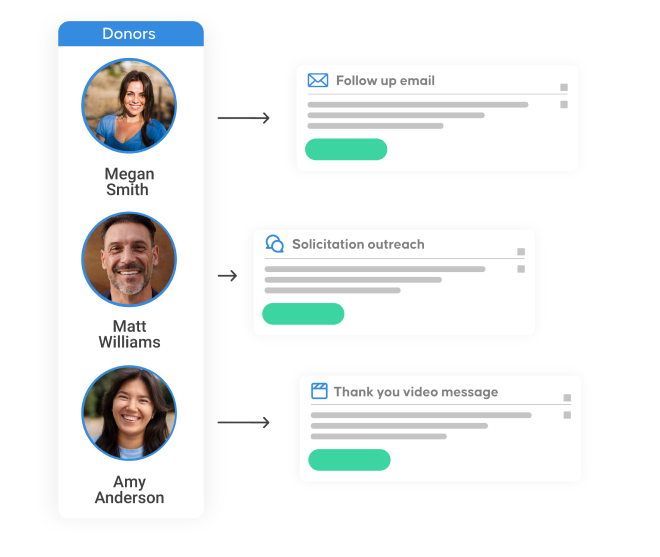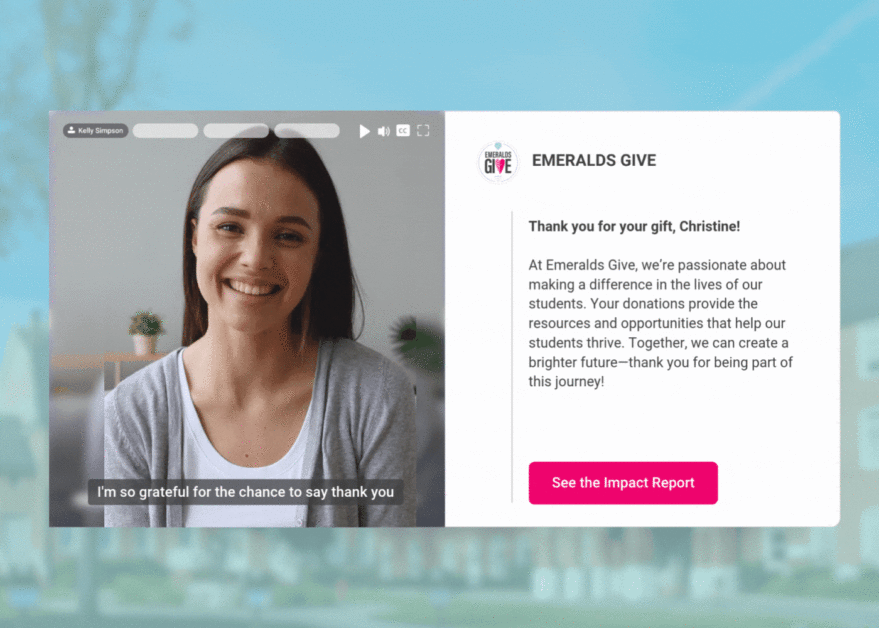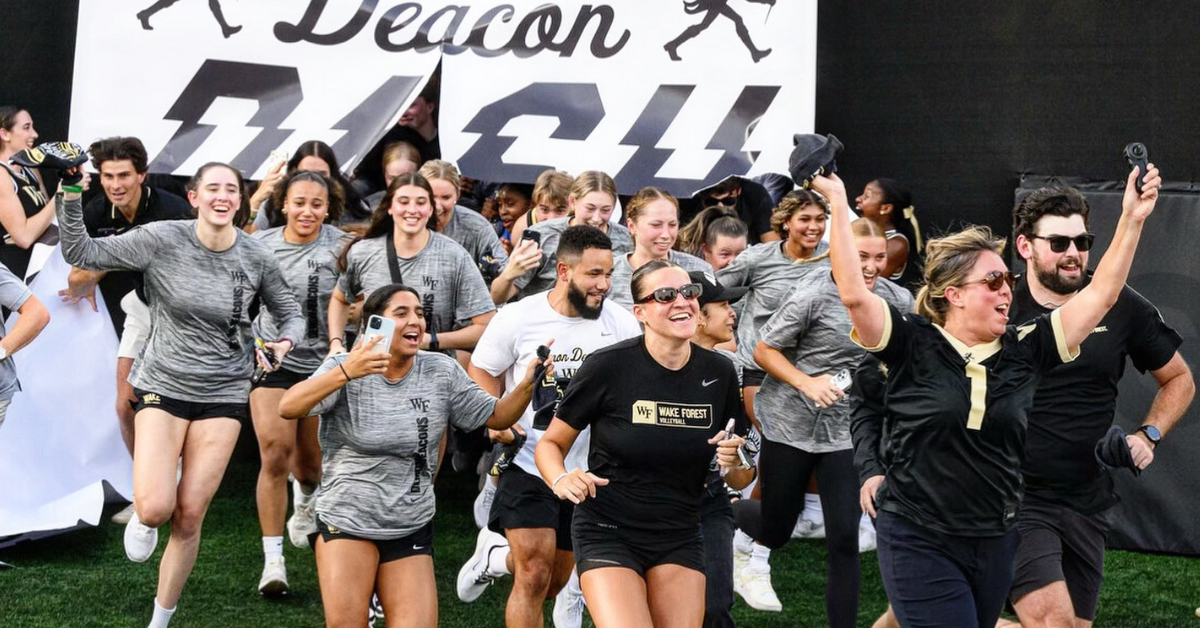Building better alumni email campaigns: How automation improves outreach and results

Email has become a reliable cornerstone of alumni engagement due to its scalability, the potential for personalization, and accessibility to users of every age, background, and experience level.
Advancement professionals and engagement teams need solutions that work at scale while still delivering meaningful, timely messages to speak to their audiences directly. Automated email campaigns combine the wide reach and proven reliability of email with the expanded toolset and efficiency of AI, freeing up limited staff resources while improving engagement.
We’ll break down how you can use AI within your own organization to organize, plan, structure, and launch email campaigns that not only reach your alumni, but connect them to your community and move them to act.
Why email remains a critical channel for alumni engagement
With an audience of billions of users worldwide, email has continued to deliver results for higher education. In just 2024, marketing revenue from email marketing was projected to surpass $9.5 billion, making it one of the most effective and highest-ROI channels across multiple industries and markets.
For advancement and alumni relations teams, email’s flexibility is especially valuable. Email marketing supports targeted segmentation, provides avenues for event promotion, alumni storytelling, and direct calls-to-action for donors; all with minimal investment in technology. Perhaps more importantly, email works across generations, from recent graduates to long-term alumni.
You and your institution own the data, control the message, the timing, and can customize your outreach to speak directly to the audience you’re targeting.
These factors have long made email essential in any advancement strategy, and when paired with smart automation, frees up team capacity while empowering them to do more and increasing their effectiveness.
Choosing a platform that supports automation
Not all email tools, or AI for that matter, are built for advancement. Institutions and alumni organizations need platforms that integrate easily with CRMs, offer intelligent behavioral segmenting, and that enable and support AI-powered personalization, all while provide real-time performance metrics that allow teams to react and adjust quickly to changing demands.
Raise from Gravyty was designed specifically for fundraisers and their teams, and offers capabilities built to expand and enhance institutional advancement. With Raise, teams can use AI to generate enhanced email drafts that align with mission and tone, speeding up production without sacrificing message quality, as well as tracking donor behavior and response, helping fundraisers prioritize outreach, and follow up efficiently and effectively.
See Raise in action
Some alumni engagement platforms also offer built-in automation that supports consistent touch-points without requiring manual effort. Graduway enables teams to automatically send birthday messages, mentorship reminders, and periodic class year updates, streamlining communications that would otherwise demand administrative time.

Used thoughtfully and intelligently, these automated messages can strengthen your connection to alumni and keep them engaged and active all year, every year.
Working together, tools like Raise and Graduway help advancement teams scale their outreach and build stronger, more personal alumni relationships without requiring more or already-limited staff time.
Segmenting and structuring the email campaign
Intelligent and purposeful audience segmentation is at the core of any effective campaign. Instead of sending the same message to every email, break your alumni list into segments based on criteria like:
- Class year or graduation decade
- Giving history (first-time, LYBUNT, major donor)
- Previous or recent event participation
- Affiliation (athletics, regional chapters, reunion classes)
- Engagement level (recent activity, platform usage, email behavior)
Each of your audience segments should align with a specific goal. Goals such as re-engagement, stewardship, solicitation, event attendance, each have distinct target audiences, and your campaign structure should support that outcome.
For example, a re-engagement series for previously-active donors might include three messages over a six week period, while a class reunion campaign could run over the course of several months and include periodic updates, calls to register, up to final, day-of reminders and follow-up after the event.
Plan your email cadence in advance. What messages each segment will receive? When should they receive them? And how will content improve progress toward the goal? Automated scheduling makes this easy once the structure is set.
We recommend developing compelling and personalized emails before beginning key campaigns, then using AI tools to automate the cadence and personalization at scale.
Segmenting upfront, and doing so with your goals in mind, doesn’t just make your emails more relevant to their intended audience, it also makes your campaign easier to manage and the results easier to measure.
Writing emails that inspire action
Automation delivers the message, but it’s the quality of your content that drives responses.
Every email you send in your campaign should be clear, focused on a specific goal, and written with a well-defined audience in mind. Best practices include:
- Compelling subject lines: Capture attention in 6–10 words. Avoid generic phrases.
- Concise copy: Use short paragraphs and direct language. Make your point quickly and avoid fluff.
- Alumni impact stories: Share real stories showing the visible and measurable outcomes of giving: like scholarships, campus improvements, or mentorship success.
- Visual elements: Use relevant, current images when possible: such as alumni at recent events or students benefiting from programs directly supported by donations.
- One clear CTA: Whether it’s “Donate,” “Join,” or “Register,” be specific, clear, and prominent.
Personalization matters. Alumni should feel like the message was created for them, not sent to thousands. Use tokens (first name, class year) and refer to known engagement (e.g., “Thanks for attending Homecoming last fall”).
Gratavid, Gravyty’s video messaging tool, can enhance this further with the inclusion of video. Advancement teams, or campus partners like faculty, staff, or coaches, can send customized, personal video messages directly to alumni to thank them for a gift, highlight an upcoming event, or share program updates.

Adding video into outreach creates student engagement with a personal connection that text alone can’t match. It’s especially effective for stewardship and major donor cultivation, but it works just as effectively in automated campaigns when used thoughtfully and purposefully.
Sharing real stories, from real people, can help alumni understand how their involvement or support makes a difference and show them a direct, measurable, impact. Highlight the tangible results of donor contributions, like student scholarships, mentorship successes, or new initiatives, to reinforce connection and prompt action.
Setting up the workflow: Triggers, timing & tools
Once your content and segments are mapped out, it’s time to build in the automation. The most effective and impactful workflows are triggered by specific behaviors, personal milestones, or calendar dates. Some examples include:
- New graduate welcome series
- Birthday emails
- Giving Day countdown and day-of reminders
- Reactivation emails for lapsed donors or dormant accounts
- Mentoring nudges or community activity updates
This type of automation ensures emails are relevant and timely without requiring staff to monitor calendars or track behaviors manually.
Graduway can send mentorship reminders and class year activity updates automatically, keeping alumni informed about new opportunities or classmates who’ve joined the platform.
Meanwhile, Raise can help target follow-up based on interest area or behavior, and send high-priority messages to volunteers or prospects aligned with key initiatives.
Email is the top marketing channel for automation, with 58% of professionals relying on it over content or social media.
That’s because, with the right timing, automation purposefully based on behavior or lifecycle stage, drives significantly better results than scheduled blasts.
Whether you use a visual workflow builder or CRM-based behavioral triggers, the structure should align with the alumni journey: onboarding, engagement, participation, giving, stewardship. Once it’s live, automation ensures the right message always goes to the right audience at the right time.
Measuring and iterating based on performance
The power of automation isn’t just in execution; it’s in optimization. Performance data from your campaigns, which messages resonated and those that didn’t, should inform every step that follows.
Key metrics to watch include:
- Open rate: Measures subject line effectiveness and list hygiene
- Click-through rate (CTR): Indicates content quality and CTA clarity
- Conversion rate: Shows how many recipients took the desired action
- Unsubscribe rate: Helps spot relevance or frequency issues
Campaigns and goal-specific messaging should be A/B tested wherever and whenever possible. Keep changes simple: try two different subject lines or small content variations for a sample audience, then send the winning version to the full segment. Your results might find that recent grads respond better to video, where older alumni prefer event invitations in calendar-friendly formats. You can then tailor your wider message more directly to your goal audience.
Raise provides granular analytics so fundraisers can track not only who reads and clicks, but how your donors behave over time. If someone opens three emails but never clicks, you may want to try a different approach like including a video message. If they click often but never donate, it might be time for a more personal, individual follow-up.
This level of insight allows your campaign to evolve based on what’s working. Use performance trends to adjust messaging, pacing, or even further refine your segmentation strategy. The result is an ongoing improvement feedback loop; not a set-it-and-forget-it campaign.
Real-world results: Wake Forest University
Wake Forest University faced a familiar challenge: a large, scattered alumni base and limited staff capacity. By implementing Gravyty’s AI-powered advancement tools, the team built a campaign that exceeded expectations.
WFU launched a custom Giving Day microsite and—using omnichannel messaging including both automated emails and personalized video—drove participation. Raise enabled them to surface previously untapped donors and prioritize high-value, personalized outreach.
The result? A $120,000 gift from a previously unengaged donor and donor participation rates that exceeded goals by 14.3%!
Their strategy worked because they combined careful and thoughtful campaign planning with technology purpose-built for advancement. Smart automation handled the scale, while personalized content and AI-powered prioritization delivered results.

Making the most of every message
Email remains the foundation of scalable alumni engagement because it works. When paired with intelligent, guided automation, it becomes a powerful tool for building relationships, increasing alumni participation, and driving donor action without overwhelming your staff.
Segment your audience, define your goals clearly, create meaningful and personal content, and set up smart workflows and processes that reflect the real alumni lifecycle. Then measure, learn, and optimize to make future messaging more effective.
Whether you’re just starting or scaling an existing strategy, platforms like Raise and Graduway make it possible to automate outreach without losing the human element.
Explore how Gravyty can help your team build personalized alumni engagement at scale through automated email. Let’s talk.



